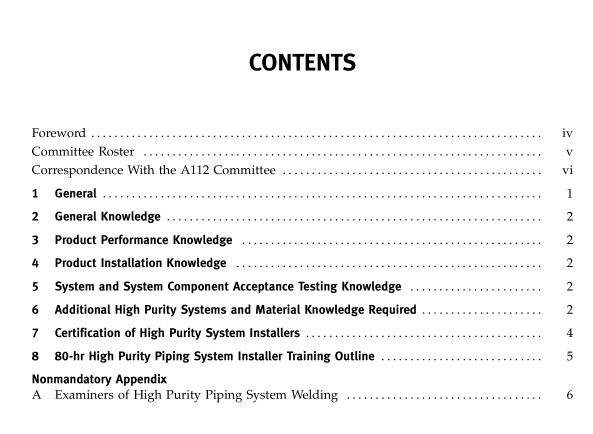ASME A112.20.1:2004 pdf download Qualification of Installers of High Purity Piping Systems
6.4 Nonmetallic Joining Techniques
The high purity piping system installer shall under-stand the following nonmetallic joining techniquesfound in standards referenced in para.1.3 and appro-priate manufacturers certification requirements:
(a) butt fusion
(b) socket fusion
(c)lR-fusion-infrared butt fusion
(d) bead and crevice free fusion process(e) mechanical connections
(1) flanges
(2) threads
(3) sanitary fittings(4) unions
(5) flair
(6) compression
(7) metal-to-plastic transition joints
7CERTIFICATION OF HIGH PURITY SYSTEM
INSTALLERS
7.1 Overview
Certification to this Standard shall be through an ISo/IEC 17024 ANSl accredited third party certifier. Certifi-cation shall include the successful completion of a mini-mum number of hours of training appropriate for the
level of qualification outlined inparas.1.2 and 7 of
this Standard that includes a written and a practicalexamination covering all facets of this Standard.
7.2 Practical Experience
7.2.1 Level 4.The qualified Level 4 high purity pipingsystem installer shali have a minimum of four yearsof documented practical experience (recognized by theANSI third party certifier) in the installation of pipingsystems.
7.2.2 Level 5. The qualified Level 5high purity pipingsystem installer shall have an additional two years of
documented practical experience (recognized by theANSI third party certifier) in the high purity field.
7.3 Recertification of High Purity Piping System
lnstallers
All levels of high purity installer certification shall berenewed at a minimum of every five years. Recertifica-tion shall include a written and practical examinationcovering all facets of the latest edition of this Standard.7.4 Metallic Welding Qualifications
Each welding procedure, welder, or welding operatorshall be qualified in accordance with Section IX of theASME Boiler and Pressure Vessel Code, as specified inASME B31.1 and ASME B31.3. In addition,each orbitalwelding operator shall qualify separately on the smallest examination of exterior and interior surfaces by theQAR(Quality Assurance Representative).
7.5 Nonmetallic welding Qualifications7.5.1 Examination Procedure
7.5.1.1 Examination.The qualification examinationshall consist of a written, practical, and, when appro-priate, oral examination by the QAR.
7.5.1.2 Passing Criteria.The high purity Installershall have achieved at least an 80% correct score to passthe written qualification examination.
7.5.1.3 Continuity. Continuity requirements shallbe the same as those contained in Section LX of the ASMEBoiler and Pressure Vessel Code.
7.5.2 Practical Skills and Knowledge
7.5.2.1 Methodology. The nonmetallic welder shallprove his practical skills in accordance with the method-ology being employed.
7.5.2.2 Testing. Testing shall include the following:(a) materials technology (thermoplastics)
(b) welding principles and joining methods
(c) context between temperature, pressure, and timeid) choice of parameters
(e)designation and rules for the processing of plasticsand filler materials to which the examination is designedto apply
(f)meaning of standardized welding signs andsymbols
(g) types and shapes of welds
(h) requirements of the welding equipment(ü influences on the weld quality
7.5.3 Welding Performance. The qualified installershall demonstrate knowledge concerning the following:a) proper preparation of the work pieces for welding(b)proper operation of the welding equipment(c) preventing and correcting faults when welding(d) prevention of accidents and fire damage
7.5.3.1 Test Piece Preparation.The dimensions ofthe test pieces are dependent on the process,the mate-rial,and the work piece thickness and filler material(when necessary). The candidate shall prepare the testpieces in an approved manner for welding.The fabrica-tion of the test pieces shall be judged according to thefollowing:
(a) determination and choice of the welding parame-ters,including the actual measured values
b)preparation of the joint and welding filler
lc) adjustment and handling of the weldingequipment
d) control measures and recording
ASME A112.20.1:2004 pdf download
